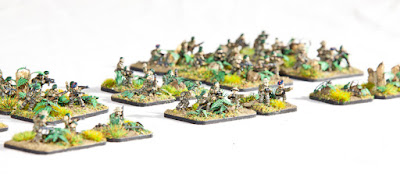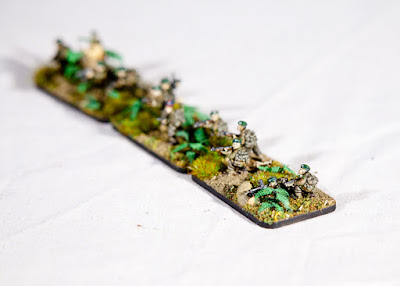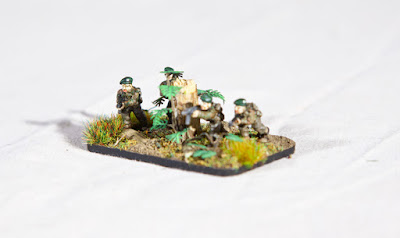When I decided to take the plunge and start getting my Indochina stuff done I spent a lot of time looking around at the kinds of bases that people were doing for Asia and such like and there wasn't much that I could find that really inspired me, in fact a lot of the bases that I had seen were either very reminiscent of European terrain or else they weren't available for the 15mm scale so I had to sit back and have a think of what I wanted.
The majority of the fighting in Indochina didn't take place in the deep jungle (with the significant exception of the Route Coloniale 4 disaster, when the Union troops struck out into the jungle away from the roads in an attempt to escape the VM) so the majority of bases that I had seen are very passable so no problem there... but I wanted something a bit different. I wanted something that screamed jungle and rain forest.
Anybody that has spent time in a jungle and/or rainforest (and Ive done both) will immediately be able to say that there is more dead stuff there and than alive and the ground covering is a deep mixture of light brown and deep brown/ black and the foliage can be so green its like a slap in the face... and then of course in the right season there is, in parts, a riot of colour with flowers and blossoms and such like, as well as the trees root structure running rampant across all pathways.
Now, this creates a bit of a dilemma because a base that is done this way will look very dark and at 1/100 scale its really important to have a demonstration of contrasts to highlight and draw attention to the details. Because of this one of the choices I made is that I wouldn't just have dead ground covering and instead mix up some materials with some brighter and lighter choices to create a bit of a lighter contrasting texture.
The next big problem was how on earth would I be able to replicate the foliage of a jungle on each base? Well that turned out to be easier than I thought with the beauty of brass etched foliage for Architectural Models...
and so this is how I did the bases:
1) Mount the painted figures directly to the base that you have chosen to use. For me I always use 2mm MDF Flames of War bases from Tony at East Riding Miniatures (http://shop.eastridingminiatures.co.uk) and for those of you who are interested, Tony also carried the Platoon20 line of Vietnam miniatures for the American War.
2) Mount a collection of Rocks and/ or Tree stumps. The rocks that I use are the kind of small pebbles you get for fish tanks, or small chalk chips that you can cut to shape. For the tree stumps I headed out to the garden (fortunately it being winter here there is a lot of this stuff laying dead all over the place). I got a big handful of twigs and cut and shaped them to the sizes I needed to fit them onto the bases. The selection of rocks and twigs that I had chosen were then glued straight onto the base using PVA glue and left to dry.
3) The next thing to be dealt with was the tree roots that spread across the jungle floor and break through the surface. For these I used Green Stuff, made appropriate lengths of the stuff and then stuck them to the bases with the sculpted details being applied once the roots were positioned securely.
4) To provide some unification of all the details on the base a layer of tile grout needs to be applied. Different people use different things. When I was younger I used to use plaster of paris but tile grout is far better due to the way it deals with water. Plaster would crack, grout doesn't... and grout doesn't shrink at all when it dries so this is what I used. I apply it with a palette knife (a mini one) and cocktail sticks to work them into the awkward areas. The grout is then left to dry completely.
5) Now the tile grout is fine for areas of mud BUT I personally am not a massive fan of the texture and Im never convinced by the way grout/plaster with a coat of paint looks. Its always made my miniatures look a bit crap so now I put a layer of fine grade sand everywhere that will be left exposed using PVA glue painted on with a brush.
6) Once this is done and dry as a bone the entire base (including the rocks but NOT the stumps) is painted using Vallejo German Camo Medium Brown (826) and left to dry
7) The base then has a heavy dry brush of Vallejo Green Ochre (914) is applied and left to dry
8) Im a real fan of the static flock grass clumps that you can buy off of Ebay and I happened to have a load of choices that I had bought for my Polish army which I had decided were not appropriate for the basing I was doing for them so I had a lot left over. I had looked at my bases and noticed that with the brass etched foliage I was going to apply, it wouldn't have made the bases 'busy' enough for my tastes and so I used a couple of these clumps on each base to replicate the thick undergrowth you can see in the Asias.
9) The next thing to make choices on were the actual ground covering itself, the lead litter, biological mulch and detritus that is so characteristic of forests and jungle. I knew, I just KNEW that a layer of static flock would just look crap so I decided to have a look around for some more textured ground layers. I knew that the war-games market probably wouldn't be able to provide this so I headed over to the fine scale modelling corner of the world and soon found a company called Reality in Scale based in the Netherlands (www.realityinscale.com) who trade in a vast range of military diorama materials. They had a great selection of interesting ground materials of which I bought a good selection. When I had them in hand I mixed three of them together (1x Mossy Forest, 1x Fine Dark Forest and 1x General Green Scatter) into a plastic tub and shook it vigorously to produce my own mix. The final result wasn't as dark as I was expecting but nonetheless it was useable... and so this is what I glued (using PVA glue painted on) on all areas of the base that needed ground covering.
10) The next big challenge was the foliage that was raised from the base, and hanging from stumps and rocks. The only viable choice here, I believe, was to use brass etched foliage sheets. After a lot of looking around I settled with buying a selection of sheets from Scale Link (www.scalelink.co.uk) choosing SLF 065 - Tropical Tree Creeper , SLF 040 - Bracken Fronds and SNF 032 - Pond and Canal Plants. They have a vast range of foliage options at different scales and whilst not the cheapest options in the world, are definitely worth their expenses in the final analysis.
These sheets were primed and undercoated black and then were cut from their sheets, and applied to the bases into pilot holes previously drilled into the bases and glued across the ground or across tree stumps and boulders wherever necessary and positioned to represent a good covering of the base.
11) The entire foliage mass is then painted with Vallejo German Camo Medium Brown (826) for the branches and woody parts.
12) The foliage is then firstly base coated with Vallejo Extra Dark Green (896) and then highlighted with Extra Dark Green mixed with Vallejo Intermediate Green (891) and the final highlight of Games Workshops Putrid Green to make the green really pop.
An easy way to paint the foliage is to firstly paint a thin line down the centre of the frond and then paint all of the frond lobes on each side together with one stroke leaving a darker green dividing line between the frond core and the lobes.
... and there you have it! Jungle bases done!





































































